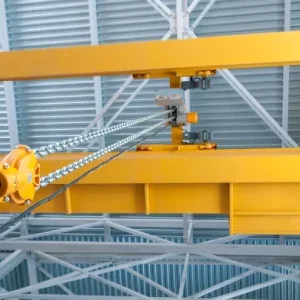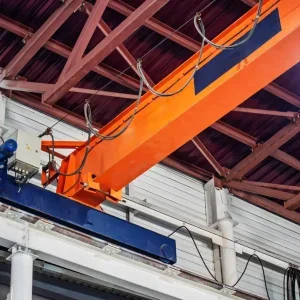In Germany, the EU provisions are complimented by the Institution for Statutory Accident Insurance & Prevention (Berufsgenossenschaft VBG) published as BGV-C1in 1998. This is a code of practice for entertainment and theatrical venues to use for designing their operations. Lifting and rigging equipment forms part of the code. Adopting BGV-C1 is entirely voluntary – but its adoption is generally required by insurance companies in Germany, and therefore it has effectively become an industry standard. BVG-C1 requires overload protection that cuts off not just the overloaded hoist but also the central control system.
Since promulgation, the EU provisions have been revised and their latest publication is enthusiastically awaited.
The regulation has had two basic effects. First, it has made the provision of overload protection in units over 1t a fundamental accepted feature – to the extent where questions of cost do not apply. Interestingly though, as Derrick Bailes, chief executive of the Lifting Equipment Engineers Association (LEEA) points out, the regulations are not retrospective.
Which of course means that it is perfectly legal to operate cranes without such equipment provided they were built before 1992. This has meant that retrofit has become significant business for some suppliers.
In general, the provision of overload protection for cranes and hoists over 1t is considered to have worked well and there is certainly no argument over their continued use or efficiency. “We install overload protection as part of our crane service,” explains Greg Rhymes from Demag. But, he confirms, “there are still a number of cranes operating without them.”
The issue is not completely dead however. It has been noted that in Liverpool alone this year there have been two fatal accidents connected with crane collapse (albeit in the construction sector). In late March a 30m long crane overturned killing one man and in January another worker was killed when a crane collapsed on top of him. Overload has not been ruled out in either case. Death and destruction on a frightening scale can also be caused by overloading in the factory environment.
There is also the vexed issue of enforcement. According to clause 113 LOLER 1998, crane inspections would normally be carried out by an “in-house competent person” and include visual and functional checks, for example that the alarm operates correctly on a crane overload device. They may be “weekly or less frequent (monthly, quarterly) and will normally be carried out on machinery, for example, a crane, rather than accessories (it is considered that detachable chains and slings, etc should receive a pre-use check by the operator, rather than periodic inspections).”
The weekly or monthly inspection regime is interesting in itself since claims they have never been inspected at all. It is also notable that there is no provision for the inspection of “accessories”.
Derrick Bailes also points out that the commonly held idea that the machinery directive excludes units under 1t is also not entirely correct – the directive also applies to devices which have a swing rate of 40,000 Nm which means it applies to most mobile cranes, though not hoists or chain blocks of course, or jibs attached to a wall. The lack of regulation for non-electrical hoists and crane units under 1t is felt to be an anomaly, none more so than by the Belgian government, which is seeking to get regulation of friction clutches at the point of 1.25 Working Load Limit (WLL). Keith Rainford, of Street Crane, agrees that, “there is no reason why there is no regulation of overload safety of units under 1t. One presumes that there is no pressure to have any.”
Charles Gillespie, sales and marketing director for Certex UK Ltd, says there is “no real reason” why there are no standards – “certainly the amount of damage caused to people and machinery by overloading accidents are quite severe. And you can certainly see occasions where hoists etc are being operated at significantly over capacity – extensions to jibs etc.”
However it is a different story when it comes to slip clutches and other mechanical devices used on the units of under 1t. Electronic devices can cut in at 100% of capacity if required. In the case of slip clutches etc anything up to 115 to 130% have been registered.
According to the materials handling boss at CERN, Ingo Ruehl: “The accuracy becomes more important with the increase of the crane capacity. An overload protection of +5% of a 5t crane will only sum up to 5.25t whilst 5% of an 80t crane will sum up already to 84t before the overload protection system triggers!”
For EOT cranes with huge lifting heights, respectively lifting depths, the cable weight has also to be taken into consideration. If the overload protection system is too accurate it may trigger already with a nominal load being lowered to the bottom of the shaft (100-150m) where you have to add the entire weight of the wire rope(s).
Overload protection may in general work with some precision with electronic and major units, but mechanically operated equipment is of course different. Yes, this is a pretty unusual application example, but the point is worth noting.
In this area slip clutches are one of the most common forms of overload protection. They work but not without difficulty. “The issue with slip clutches,” explains Greg Rhymes from Demag, “is the need for them to avoid cutting in every time there is a sudden snatch. The point is you do not actually want or need complete accuracy. Mechanically operated hoists rely to a certain extent on their flexibility for their efficiency.”
Keith Rainford agrees: “Slip clutches are not the most precise of devices, they are not really meant to be. If you want something more precise then you use something electrical, otherwise a slip clutch is more convenient.” Obviously, he continued, “operators of these units can see accurately what they are doing and the need for precision generally is not as acute as if you were trying to lift 20t or so.”
For Kito Europe technical officer Udo Kleinevoss an electronic overload safety device works much more accurately than a slip clutch. The electronic overload safety device switches off the device at 125% – with a normal slip clutch it can be 130% or more.
Two efficient electrical units available are the Dillon Dyna Switch. This particular unit uses a force beam which can operate in tension or compression. Each beam can accommodate from one to four switches which can be set to operate as many as four different switching functions or combinations including slackline detection. When activated the unit not only shuts off power when an overload condition exists, but they can also be set to operate lights, buzzers or klaxons to warn the operator of an impending overload. Closer to home there is the W940 from Rayco Wilie. The key feature of this unit is that it provides the operator with a continuous visual indication of the safety margin which enables the continuous monitoring of loading.
Of course the flexibility inhibits the use of electrical switches which because of their very nature tend to cut in automatically, and then need a procedure to release.
This can encourage a tendancy to extend the tolerance of electrical switches during use, which, of course, ultimately undercuts the whole safety value of units.
But since there is no proper inspection regime the issue does not arise.
Overload protection also comes at a cost. This could be one reason why UK manufacturers are not pushing for standards to be established. Charles Gillespie estimates that overload protection devices can add about 10 or 15% to the price of a unit – which he claims is still “saleable.” Overseas, the costs are considered not significant. “Price is not a huge issue,” says Jan Boettcher, managing director, German-based Kuehnezug Foerdertechnik. “In Germany it is generally accepted,” he adds.
Certex has recently launched a range of chain bocks and level hoists – the bulldog range. These have weather protected Weston Brakes as standard. “This is simply part of our offering with the new range,” explains Gillespie. “We see it as a selling point.”
Jan Boettcher says overload devices have become accepted in Germany for all types of hoists and lifting equipment – “not having an official standard for devices under 1t is not really an issue here.” It is not an issue for some in the UK either. Ian Watson from Linnian Hoist and Cranes says “we have never had a client actually ask for an overload protection device to be fitted to any of our hoists. They probably assume they are fitted now as a standard. Certainly they have never emerged as an issue.”
Greg Fardel from Morris Material Handling says “most of these devices are included in our hoists – I can’t recall a client asking for one to be connected to any particular standard.”
As one Australian retailer made clear, “tools of this capacity might have any number of safety devices but to the man in his garage or small business they are going to “tailor” them to suit themselves and the work they are doing – any real type of standard would be meaningless.”
Overload protection in cranes and hoists has long passed as an issue in units over 1t, save in legacy retrofits. There is still some confusion in the less than 1t category though. The general view is that accuracy is not needed in these devices and with chain hoists in particular the rough and ready slip clutch is still the best option, or at least it seems to please more than most.
Charles Gillespie (left), sales and marketing director for Certex UK Ltd, says there is ‘no real reason’ why there are no standards for units under 1t overload 1 Street Crane’s ZX hoist overload device overload 2 An electronic load indication system from Street Crane overload 3 LED load display overload 4 Overload protection may in general work with some precision with electronic and major units, but mechanically operated equipment is of course different overload 5 For Kito Europe technical officer Udo Kleinevoss an electronic overload safety device works much more accurately than a slip clutch kito 1 This electronic overload safety device switches off the device at 125% – with a normal slip clutch it can be 130% or more kito 2






